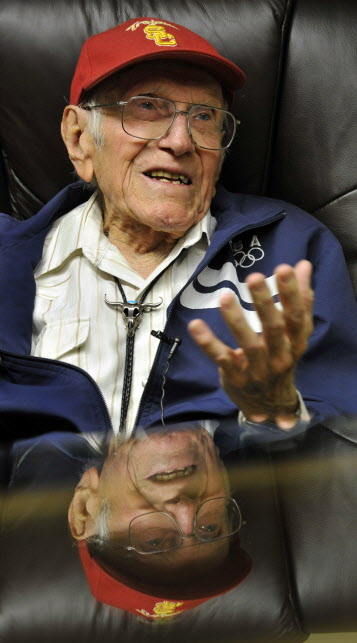 Paul Dietzel holds a photo of ‘Banana Boat,” the B-29 he piloted in bombing missions over Japan in World War II. (Photo by Bill Feig, used by permission of The Advocate, Baton Rouge, Louisiana)
Paul Dietzel holds a photo of ‘Banana Boat,” the B-29 he piloted in bombing missions over Japan in World War II. (Photo by Bill Feig, used by permission of The Advocate, Baton Rouge, Louisiana)
By George Morris
Much of the memorabilia that Paul Dietzel kept at his Baton Rouge home involved a legendary sports career — All-America football player, national championship at LSU, connections to such coaching legends as Paul Brown, Bear Bryant, Earl Blaik and Sid Gillman.
Among the plaques, posters and game balls, however, was a photo of the B-29 bomber he flew over Japan in World War II, years before the lesser combat of football made him famous.
There is no question, Dietzel said, as to which experience was the more important.
“Those two and a half, three years, that was the greatest part of my life,” Dietzel said. “I owe it so much.”
Continue reading “Before his football fame, World War II shaped Paul Dietzel”

 A German Messerschmitt Me 163B Komet rocket-propelled fighter at the National Museum of the United States Air Force, Dayton, Ohio (Public domain photo)
A German Messerschmitt Me 163B Komet rocket-propelled fighter at the National Museum of the United States Air Force, Dayton, Ohio (Public domain photo) Gen. Dwight Eisenhower speaks with paratroopers shortly before they board airplanes taking them into Normandy on D-Day. (National Archives)
Gen. Dwight Eisenhower speaks with paratroopers shortly before they board airplanes taking them into Normandy on D-Day. (National Archives)
 A B-25 launches from the USS Hornet on April 18, 1942, as part of the Doolittle Raid on Japan.
A B-25 launches from the USS Hornet on April 18, 1942, as part of the Doolittle Raid on Japan.